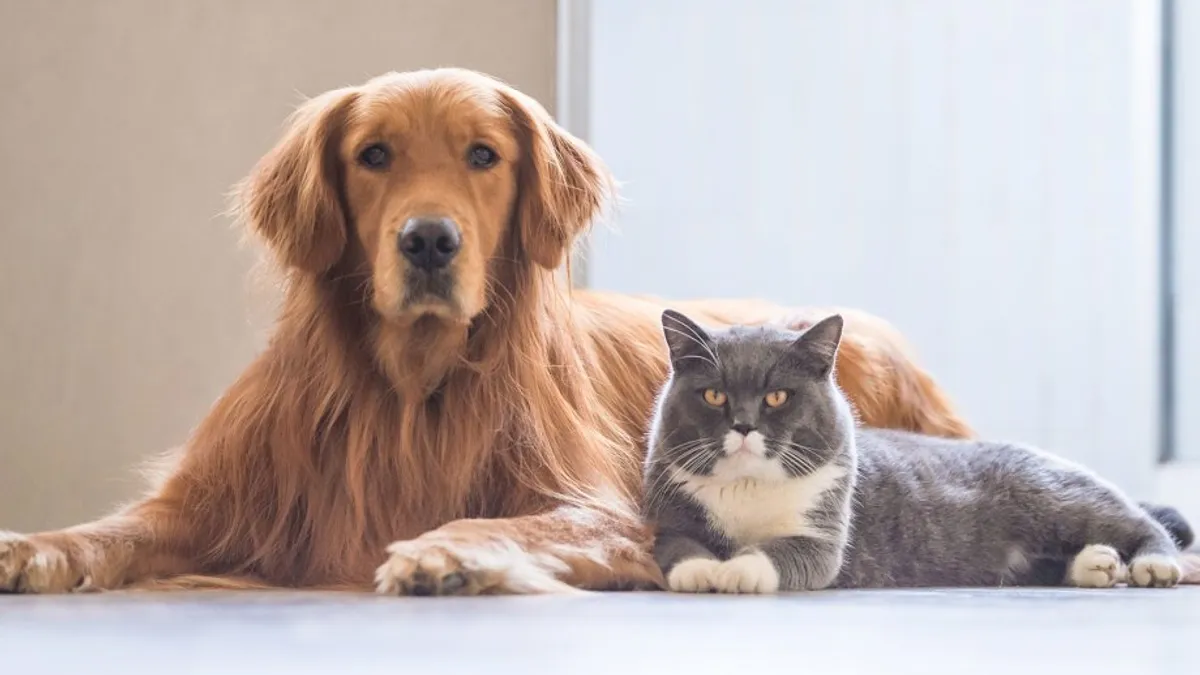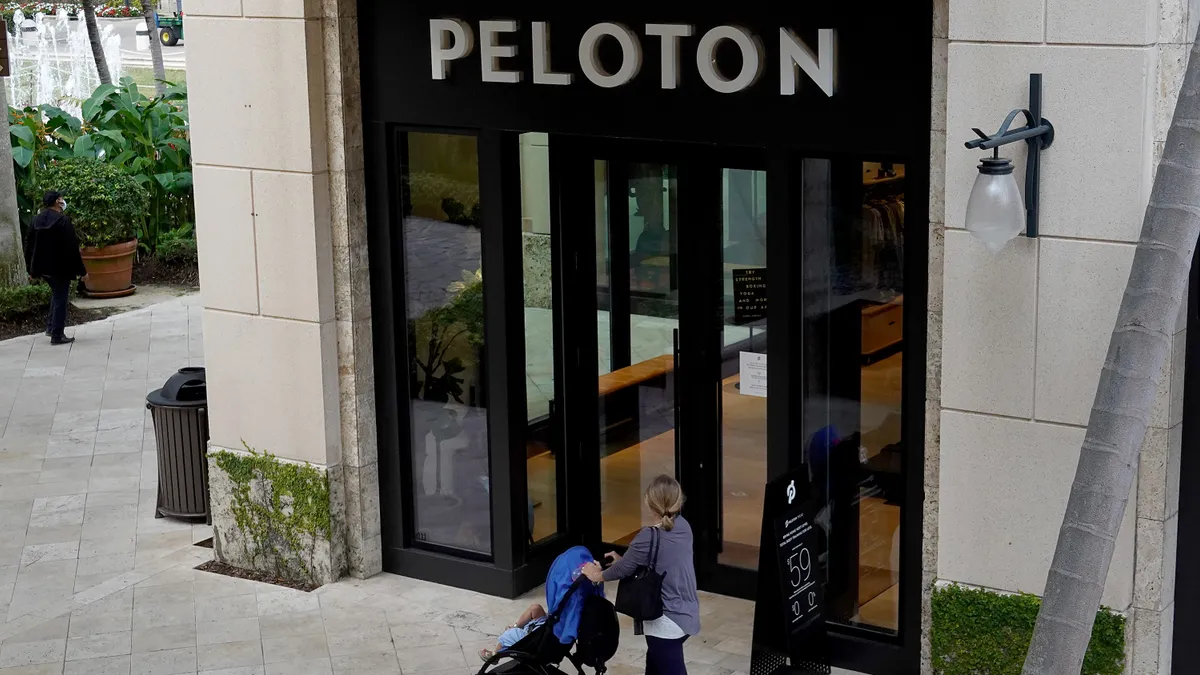Not too long ago treating pets like human children was widely seen as socially unacceptable. But as cultural shifts ensued, so did perceptions of pet "parents." More than ever, pets are viewed as members of the family, and owners are willing to pay a premium to give them what's best for them.
Experts attribute this shift in how pets are viewed to a number of factors, including that people live alone longer and traditional family timelines are delayed. Owners' willingness to pay top dollar for high-quality pet products bodes particularly well for retailers and brands in the space. According to a Packaged Facts study emailed to Retail Dive, the pet market was estimated at $90.1 billion last year.
While the sector as a whole is strong and relatively resilient to economic headwinds, not every player is immune, and adjustments must be made.
Premium products take off
Retailers have responded to consumers' craving for premium-grade pet products (and their willingness to pay the premium price tag).
PetSmart in 2017 announced it was adding Pinnacle Pet Nutrition Shops, which offer products that are grain-free, organic or minimally processed. In a similar move to cater to changing consumer preferences, Petco announced last November that it would no longer sell pet food and treats that contain artificial colors, flavors or preservatives for dogs and cats. Larger brands have also expanded their offerings to include more natural elements. General Mills in 2018 acquired Blue Buffalo; Mars in 2017 unveiled its Crave brand, which features high-protein, grain-free products; and J.M. Smucker in 2018 acquired Ainsworth Pet Nutrition, which makes Rachel Ray Nutrish brand pet food. Several direct-to-consumer brands have cropped up in the space as well, including The Farmer's Dog and Ollie, in a bid to win consumer dollars.
The focus on natural products and quality for pet food parallels those occurring in the human food space, said Michael Felice, a principal at A.T. Kearney, in an email to Retail Dive. "For humans, there's the gluten-free trend. A pet equivalent to this is grain-free."
"One of the positives in the pet industry is that it's been pretty much recession-proof. It's not very cyclical."

Mickey Chadha
Vice President, Moody's Investors Service
The primary driver in this shift is the growing humanization of pets. The United States Census Bureau reported that in 2018, 35.7 million people, or 28% of all households, lived alone, compared to 1960 when single-person households were just 13%. With more people living alone, they may look to pets to fill a void.
"Companionship is an inherent tool that we as humans want. In today's society, human companionship is more difficult to come by than pet companionship," Moody's Investors Services Vice President Mickey Chadha told Retail Dive in an interview.
The average age someone ties the knot is also getting pushed back. Last year, the average age for men to get married was 30 and for women it was 28, the United States Census Bureau found. In 1950, the average was 23 for men and 20 for women.
"As millennials push out traditional family timelines and 30 becomes the new 40, pets are replacing the urge for children," said Felice, adding that the surge of "the social media dog 'mom or dad,'" is adding even more fuel to the trend toward premium products.
Despite all this good news, there are signs of potential trouble on the horizon. Morgan Stanley economists predict a 20% chance of a recession in the next year. Will the pet industry hold up?
"One of the positives in the pet industry is that it's been pretty much recession-proof. It's not very cyclical," Chadha said. "The running joke ... was that people will stop taking their own medication before they stop medication for their dogs or cats. That's how important they are in today's world."
While a consumer may be willing to forego a new blouse, the same likely won't be said for their pet's food or supplies. Although pet owners may seek out value-based products and private labels during times of financial insecurity, as a whole, the sector remains far steadier than others in retail.
"Ultimately, pets still need to eat, and millennials, in particular, see pets as a key part of their budgeting and ‘new era family,'" Felice said.
E-commerce penetration is strong and continues to grow
As with most other retail categories, the pet sector in recent years has grown online. According to the Packaged Facts report, 18% of U.S. retail sales of pet products were online. While specialty chains (24%), and discount stores and supercenters (20%) still account for more sales, Packaged Facts estimates that e-commerce will grow to 23% of the market by 2023.
"Why would you go to the store to pick up a 20-pound bag every 15 or 20 days, or every month, when it's delivered straight to your door?"

Mickey Chadha
Vice President, Moody's Investors Service
Helping to drive sales online are subscription-based services, which have gained popularity across several sectors of retail, including apparel, beauty and grocery. Not every product category performs well under this model. A McKinsey and Co. report found that nearly 40% of consumers ultimately end up canceling subscription services, with more than one-third canceling within three months of signing up. However, while some subscriptions are in categories where the products are "discretionary," Chadha said, pet food is something that needs frequent replenishment due to pet eating schedules.
"Why would you go to the store to pick up a 20-pound bag every 15 or 20 days, or every month, when it's delivered straight to your door?" Chadha said. "It takes that hassle of actually lifting that bag by bringing it to you. It's a very convenient form."
Food, in particular, is a "sticky" product in the sector, according to Chadha, because owners often find it difficult to switch products once they find something a pet enjoys. "Even if a retailer stops carrying that brand, consumers have been known to go to another place to get that same brand because the dogs or cats, or whatever pet you have, gets used to that brand and seems to like that brand only," he added.
But beyond subscription-based services, e-commerce as a whole has prevailed in the space. Convenience is a major factor, and much like the solution subscription services provide, delivery prevents frequent trips to the store where the consumer is forced to haul heavy bags of food.
Amazon has increased its pet offerings through its Wag private label brand, which launched last year. Cat- or dog-owning households that used Amazon surged from 27% in 2014 to 38% for dog owners and 40% for cat owners in 2018, according to Simmons consumer survey data cited by Packaged Facts.
Chewy, which was acquired by PetSmart in 2017, has held its own against the e-commerce giant. In August, Chewy's American Journey label brought in $940,000. During the same period, Amazon's Wag generated $345,000 in sales, according to a 1010data report.
Consumer behavior when shopping for pet food online differs from when they shop for their own groceries, a segment that hasn't experienced widespread penetration. A recent Coresight Research survey found that 2.2% of food and beverage sales in the U.S. were done online last year.
Consumers enjoy going into a physical store to purchase their own food in order to check for freshness, whereas pet food, for the most part, is packaged, eliminating this issue, Chadha said. "It's an easier transition to e-commerce." The food isn't typically refrigerated either, so brands don't need to roll out a separate base of trucks to accommodate those needs.
The future of traditional brick-and-mortar pet retailers
Consumers may lean toward e-commerce for convenience, but traditional brick and mortars aren't to be ruled out quite yet.
"A lot of people that go into a pet retailer, a specialty pet retailer, are also looking for a pet community," Chadha said. Pets are welcome in these stores to shop with their owners, who are looking to form connections with other pet owners in the store, seeking advice from associates who have expertise in the area and want a more personalized shopping experience.
"Leaning into the personalization of the pet and creating a social shopping experience is a core value driver for national specialty retailers."

Michael Felice
Principal, A.T. Kearney
Traditional retailers are leveraging store services to entice consumers to make return visits. Veterinary clinics, pet pharmacies, grooming and boarding services, among others, have been installed in existing stores as a way to offer consumers something they can't get shopping online. Walmart in May announced it will open 100 in-store pet clinics over the next year, and begin carrying pet prescriptions in its pharmacies and on WalmartPetRX.com. About a year ago, Petco rolled out PetCoach, a pet health and wellness concept that offers on-site services like grooming, training, vet care and daycare. The store also encourages interactions among guests and their pets and hosts educational events in its casual gathering spaces.
"Leaning into the personalization of the pet and creating a social shopping experience is a core value driver for national specialty retailers," Felice said.
However, perhaps the most valuable strategy for players in the pet space is learning to integrate e-commerce and brick and mortar seamlessly, whether that's through an acquisition or a retailer building out its own digital operations, according to Severo Gonzalez, a market research analyst at 1010data.
"There's always going to be an opportunity to marry the two, it's pretty much who's going to do the best job in doing that," he told Retail Dive in an interview. "That is the one who's going to come out on top."
PetSmart has been reaping benefits from its Chewy arm recently. Both Moody's and S&P Global upgraded the specialty retailer after it repaid some of its debt using the proceeds generated from Chewy's IPO.
But Chadha warns that, "it's a double-edged sword. It's a positive and a negative. The success of Chewy has also come at the expense of PetSmart because Chewy has cannibalized some of PetSmart's brick and mortar sales." He predicts that if PetSmart loses more ownership of Chewy over the years, the e-commerce benefits for PetSmart will ultimately disappear.
While e-commerce continues to grow and mass merchants are taking more share, all hope isn't lost for the two biggest specialty retailers in the business. But success doesn't come without work and adjustments will need to be made.
"Five, 10 years from now, whether 3,000 stores between Petco and PetSmart will exist? Probably not. But if they invest in their infrastructure for e-commerce and have services, they can exist in a different form," Chadha said.























